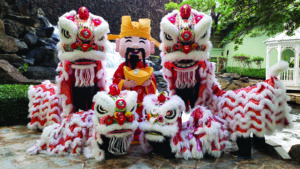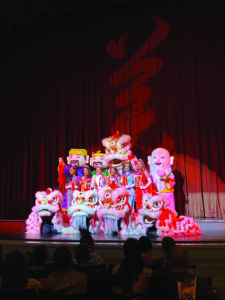 The 2024 Chinese New Year — the Year of the Dragon — begins on Feb. 10 and ends on Jan. 28, 2025, when the Year of the Snake begins. Marking the end of winter and the beginning of the spring season, observances traditionally take place starting on Chinese New Year’s Eve (Feb. 9).
The 2024 Chinese New Year — the Year of the Dragon — begins on Feb. 10 and ends on Jan. 28, 2025, when the Year of the Snake begins. Marking the end of winter and the beginning of the spring season, observances traditionally take place starting on Chinese New Year’s Eve (Feb. 9).
Chinese New Year, also called “Lunar New Year,” is an annual 15-day festival in China and Chinese communities around the world, including Hawai‘i. The first day of Chinese New Year begins on the new moon that appears between Jan. 21 and Feb. 20. Festivities continue until the following full moon, which is Feb. 24, this year.
The Chinese zodiac starts with the Year of the Rat and cycles continuously through 12 signs. The dragon is the fifth of 12 animals in the Chinese zodiac, which is based on a 12-year cycle. So if you were born in 1952, 1964, 1976, 1988, 2000, 2012 or this year, then your Chinese zodiac sign is Dragon. The dragon, a revered symbol in Chinese culture, is one of its most important mythological creatures, symbolizing strength, wisdom, honesty, benevolence, good fortune, power and prosperity.
Traditions Immigrate
Traditional dragon and lion dances are indispensable parts of community celebrations during every Chinese New Year. One of the most prominent origination theories suggests that the dragon dance began during the Han Dynasty (206 BCE–220 CE); the lion dance has its roots in the Tang Dynasty (618–907 CE).
Chinese immigrants brought their traditions to the Kingdom of Hawai‘i near the end of the 18 century. Records show that the Chinese people welcomed the Year of the Dog on Feb. 4, 1886, when the United Chinese Society of Hawai‘i held a blessing to open its King Street Hall. Princess Lili‘uokalani and other royalty attended the festivities.

Lion & Dragon Dances
Lions are considered symbols of protection in Chinese culture. Lion dances are often performed at important occasions, especially Chinese New Year celebrations, to bring good fortune and ward off evil spirits.
There are many stories about the origins of the Chinese lion dance. The most popular one involves a beast named “Nian” (“year”) that terrorized the villagers at the beginning of each new year. The monster was afraid of loud noises, bright lights and the color red, so those were the things villagers utilized to chase the beast away. Celebrations to usher out the old year and bring forth the luck and prosperity of the new one incorporated a cacophony of noise and often included firecrackers, fireworks, and red clothing and decorations. Dancers dressed as lions, the protectors of the weak, bearers of righteousness and bringers of blessings.
There are several distinctions between lion and dragon dances. Both dances are accompanied by a percussion team that plays drums, gongs and cymbals. Other instruments may be added to the musical ensemble, such as flutes, wind instruments or stringed instruments.
The lion dance is executed by two performers portraying the lion; one manipulates the head and the other moves the tail.
The dragon dance utilizes an uneven number of performers, most often, more than nine. In synchrony, dancers maneuver a long, colorful serpentine body held aloft on poles with a dragon head and tail at either end. Many dancers are needed to control the dragon’s long, undulating body, which can extend to 30 yards in length. The dragon’s body is made from thin bamboo strips covered in cloth and painted with scales. Dancing dragons are frequently led by someone holding a large sphere — either a white pearl representing immortality and the pursuit of wisdom, or a red sun representing the hope for a good harvest. Dragons most often dance during the Chinese New Year and other auspicious events that offer them a large performance area.

In Hawai‘i, lion dances are performed throughout the year at a variety of festive occasions, such as grand openings, birthday parties and weddings. During the Chinese New Year period, which spans two weeks prior to and after New Year’s Day, lion dances are performed in Chinatown and elsewhere throughout the island chain at businesses, malls and restaurants.
Unique to Hawai‘i, spectators will often feed money to the lion to receive blessings of health, wealth and prosperity. Sometimes the money is placed in a red envelope called “lai see,” meaning good fortune (Cantonese), or “hong bao,” meaning red packet (Mandarin).
The last event held during the Chinese New Year is the Lantern Festival, which honors deceased ancestors, during which glowing lanterns are floated in waterways, hung in temples or carried during a nighttime parade. A dragon dance procession through the streets highlights many Lantern Festival celebrations.
Kung hei fat choi (Cantonese)! Wishing you happiness and prosperity.
MAJESTIC CULTURE AND THE ARTS ASSOCIATION
975 Kapiolani Blvd. Honolulu, HI 96814
Kelfred Chang: 808-306-4584
majesticliondance@yahoo.com
majesticcultureandtheartsassociation.weebly.com
facebook.com/majesticliondance


Leave a Reply